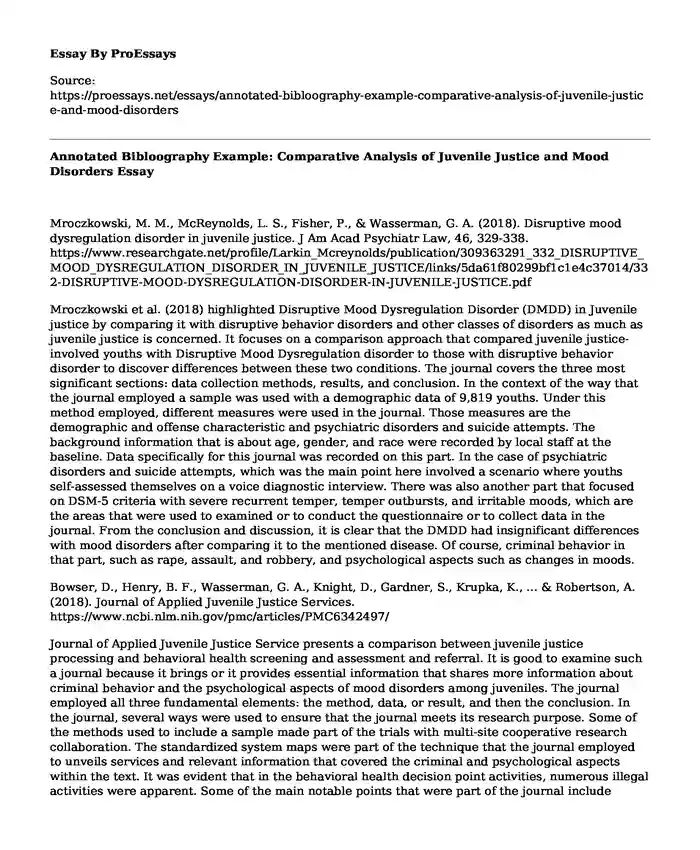Mroczkowski, M. M., McReynolds, L. S., Fisher, P., & Wasserman, G. A. (2018). Disruptive mood dysregulation disorder in juvenile justice. J Am Acad Psychiatr Law, 46, 329-338. https://www.researchgate.net/profile/Larkin_Mcreynolds/publication/309363291_332_DISRUPTIVE_MOOD_DYSREGULATION_DISORDER_IN_JUVENILE_JUSTICE/links/5da61f80299bf1c1e4c37014/332-DISRUPTIVE-MOOD-DYSREGULATION-DISORDER-IN-JUVENILE-JUSTICE.pdf
Mroczkowski et al. (2018) highlighted Disruptive Mood Dysregulation Disorder (DMDD) in Juvenile justice by comparing it with disruptive behavior disorders and other classes of disorders as much as juvenile justice is concerned. It focuses on a comparison approach that compared juvenile justice-involved youths with Disruptive Mood Dysregulation disorder to those with disruptive behavior disorder to discover differences between these two conditions. The journal covers the three most significant sections: data collection methods, results, and conclusion. In the context of the way that the journal employed a sample was used with a demographic data of 9,819 youths. Under this method employed, different measures were used in the journal. Those measures are the demographic and offense characteristic and psychiatric disorders and suicide attempts. The background information that is about age, gender, and race were recorded by local staff at the baseline. Data specifically for this journal was recorded on this part. In the case of psychiatric disorders and suicide attempts, which was the main point here involved a scenario where youths self-assessed themselves on a voice diagnostic interview. There was also another part that focused on DSM-5 criteria with severe recurrent temper, temper outbursts, and irritable moods, which are the areas that were used to examined or to conduct the questionnaire or to collect data in the journal. From the conclusion and discussion, it is clear that the DMDD had insignificant differences with mood disorders after comparing it to the mentioned disease. Of course, criminal behavior in that part, such as rape, assault, and robbery, and psychological aspects such as changes in moods.
Bowser, D., Henry, B. F., Wasserman, G. A., Knight, D., Gardner, S., Krupka, K., ... & Robertson, A. (2018). Journal of Applied Juvenile Justice Services. https://www.ncbi.nlm.nih.gov/pmc/articles/PMC6342497/
Journal of Applied Juvenile Justice Service presents a comparison between juvenile justice processing and behavioral health screening and assessment and referral. It is good to examine such a journal because it brings or it provides essential information that shares more information about criminal behavior and the psychological aspects of mood disorders among juveniles. The journal employed all three fundamental elements: the method, data, or result, and then the conclusion. In the journal, several ways were used to ensure that the journal meets its research purpose. Some of the methods used to include a sample made part of the trials with multi-site cooperative research collaboration. The standardized system maps were part of the technique that the journal employed to unveils services and relevant information that covered the criminal and psychological aspects within the text. It was evident that in the behavioral health decision point activities, numerous illegal activities were apparent. Some of the main notable points that were part of the journal include services such as the drug test, which shows that the majority of juveniles were subject to drug use. There was another crucial aspect, which was a criminogenic risk assessment. Psychological aspects were based on clinical assessments.
Udell, W. A., & Mohammed, S. (2018). The prevalence of physical health problems among youth in the juvenile justice system: A systematic review. Journal of Health Disparities Research and Practice, 12(3), 6. https://digitalscholarship.unlv.edu/cgi/viewcontent.cgi?article=1890&context=jhdrp
The journal of health disparities research and practice examined or demonstrated how youths suffer from what we call a range of health problems. It mainly focused on the physical issues faced by teenagers in the juvenile justice system. It involved other essential areas of the research, which were the method of data collection, results, and the final part of it. Apart from what the journal article presents as health problems, some cases show mood disorders and psychosocial aspects. Some of the main issues or conditions that these people or youths face in the juvenile justice system are chlamydia and Trichomonas. Though there was the case of what happens with the majority of these youths in juvenile, what brought them into this scenario unveil more about their problem and criminal behavior. Criminological behaviors are sexual assault and even rape. Rape cases were linked with pregnancies in those youths.
References
Bowser, D., Henry, B. F., Wasserman, G. A., Knight, D., Gardner, S., Krupka, K., ... & Robertson, A. (2018). Journal of Applied Juvenile Justice Services. https://www.ncbi.nlm.nih.gov/pmc/articles/PMC6342497/
Mroczkowski, M. M., McReynolds, L. S., Fisher, P., & Wasserman, G. A. (2018). Disruptive mood dysregulation disorder in juvenile justice. J Am Acad Psychiatr Law, 46, 329-338.
Udell, W. A., & Mohammed, S. (2018). The prevalence of physical health problems among youth in the juvenile justice system: A systematic review. Journal of Health Disparities Research and Practice, 12(3), 6. https://digitalscholarship.unlv.edu/cgi/viewcontent.cgi?article=1890&context=jhdrp
Cite this page
Annotated Bibloography Example: Comparative Analysis of Juvenile Justice and Mood Disorders. (2023, Oct 25). Retrieved from https://proessays.net/essays/annotated-bibloography-example-comparative-analysis-of-juvenile-justice-and-mood-disorders
If you are the original author of this essay and no longer wish to have it published on the ProEssays website, please click below to request its removal:
- Effective Learning of the Severely Disabled Students
- Paper Example on Unique Characteristics of Schizophrenia
- Essay on Personality Development Behavior Relative to Dominican Republic People
- Social Learning Theory vs. Rational Choice Theory in Criminology
- Essay Sample on Self-Development
- Essay Sample on Cyber Terrorism
- Research Paper on Height & Age: Survey Shows Relationship Between Two Variables







